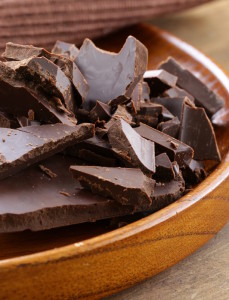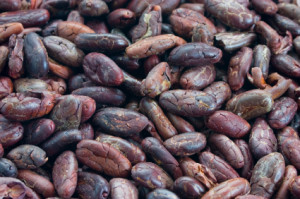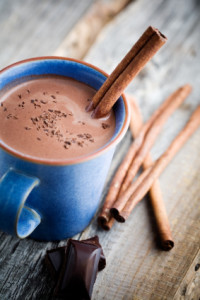Health Benefits of Chocolate and Cocoa
 Chocolate Is Divine
Chocolate Is Divine
Literally. The plant from which chocolate is derived, theobroma cacao, carries the lofty name meaning “food of the gods.” The moniker was first assigned by the Mayans and is defended today by chocolate lovers the world-over.
But what is it that creates such devotions to this ancient food source? The answer involves the abundant health promoting and feel-good compounds of cacao (or cocoa). These compounds create complex flavors while stimulating neurological pleasure centers so intensely that the effect can be recreated simply by thinking about chocolate! The health benefits of cocoa, however, extend beyond the stress releasing, feel-good sensations. In order to understand how to make the most of this amazing food source, it’s worth exploring the origins of chocolate and it’s many applications.
Understanding Cocoa: the Origins of Natural Chocolate
While no official difference exists between the meaning of cocoa and cacao, there is a commonly used convention to refer to the raw, unprocessed seeds as cacao and the more refined derivatives as cocoa.
 The cocoa bean has been cultivated for nearly 4,000 years, playing a vital role in the lives indigenous peoples of the Americas. The Aztecs ground the beans to prepare chocolate drinks and porridge whereas the Mayans also used cocoa for spiritual practices. Cacao seeds were so valued that they even served as a form of currency, meaning that, at least at one time, money did grow on trees!
The cocoa bean has been cultivated for nearly 4,000 years, playing a vital role in the lives indigenous peoples of the Americas. The Aztecs ground the beans to prepare chocolate drinks and porridge whereas the Mayans also used cocoa for spiritual practices. Cacao seeds were so valued that they even served as a form of currency, meaning that, at least at one time, money did grow on trees!
Chocolate has been shown to contain abundant health-promoting, biologically active compounds. Why then should any of us feel guilty to dive into a bit of chocolatey indulgence? While the delicious flavor of cocoa is apparent in processed chocolates, the health benefits are substantially reduced, particularly when high heat processes were used. Worse still, the heavy load of refined sugars used in conventional chocolate preparations contributes to a host of health problems (described in prior posts) that can include inflammation, insulin resistance and diabetes, essentially negating the health benefits of chocolate.
 The conversion of cocoa from a food staple to a processed, sweetened chocolate desert resulted from its popularization outside of the Americas. It wasn’t until the 16th century when cacao was introduced to Europe that sugar was first added to chocolate drink recipes. Europeans only used chocolate as a sweetened treat, considering the consumption of each a great luxury. This inspired a 17th century trend amongst the upper classes to gather in “chocolate houses” in order to indulge in hot chocolate.
The conversion of cocoa from a food staple to a processed, sweetened chocolate desert resulted from its popularization outside of the Americas. It wasn’t until the 16th century when cacao was introduced to Europe that sugar was first added to chocolate drink recipes. Europeans only used chocolate as a sweetened treat, considering the consumption of each a great luxury. This inspired a 17th century trend amongst the upper classes to gather in “chocolate houses” in order to indulge in hot chocolate.
The first European chocolate recipes relied on the Broma process to generate cocoa powder. This involves the use of a hydraulic press to remove much of the fat content from cacao seeds to make the cocoa solids more miscible in liquids. In the mid-19th century, this method was expanded to the “Dutched chocolate” process, which incorporates an alkalizing substance into the powdered cocoa solids to produce even higher solubility and a milder flavor at a cheaper price. The method was widely adopted and helped fuel the development of the modern candy industry.
Both methods of cocoa processing are still in use today however the more commonly used Dutched method strips cocoa of many of its potent health promoting compounds. Choosing only minimally processed or raw forms helps ensure cocoa can deliver its mass of antioxidants, vitamins, minerals and nutrients unmatched by any other food source.
The Many Uses of Cocoa
The production of cocoa powder reduces its fat content to around 23%, down from approximately 50% found in the whole cocoa bean. Cocoa powder is combined with milk and sugar to create milk chocolate. Dark chocolate, on the other hand, contains little sweetener and a higher concentration of cocoa solids, giving it the healthiest nutritional profile of any processed chocolate.
Purified cocoa fat is referred to as cocoa butter, unique in its ability to melt at body temperature and give chocolate its characteristic smooth texture. It is blended with milk and sugar to create white chocolate. Although this product is quite useful for skin care and many recipes, cocoa butter lacks the rich arsenal of antioxidants and mood enhancing compounds found in cocoa powder.
The Health Benefits of Chocolate and Cocoa
With more than twice as many flavor-inducing compounds than any other food, it’s no surprise that the taste of chocolate is richly distinctive. The neurotransmitters dopamine and serotonin, responsible for the experience of pleasure and alleviation of pain, are optimally stimulated by the 50:50 ratio of carbohydrates and fats present in whole raw cacao. Phenylethylamine (PEA) and anandamide, compounds that are associated with states of love and bliss, are also abundant in cocoa. PEA is a natural appetite suppressant, making natural cocoa an excellent addition to any weight loss plan. Anandamide is naturally released in the body after a bout of exercise, however cocoa is the only known plant source of this feel-good endorphin. This makes it no surprise that chocolate is the single most frequently desired food item, comprising up to 50% of all reported food cravings.
 With the ability to act as both a food and a drug, cocoa is known among nutrition experts as a “superfood.” The main attribute of this nutritional powerhouse is cocoa’s status as the world’s best source of antioxidants. It is so densely packed with these age and cancer fighters that even losing 90% of its antioxidant content through Dutch processing makes any chocolate a relatively antioxidant-rich product. The benefits of cocoa are also derived from its high concentrations of minerals essential to overall wellness and disease prevention such as magnesium, zinc, iron, copper, manganese and phosphorus. Raw cacao also contains one of the highest levels of vitamin C found in any nut or seed. This important antioxidant is lost, however, if the bean is exposed to high temperature processing.
With the ability to act as both a food and a drug, cocoa is known among nutrition experts as a “superfood.” The main attribute of this nutritional powerhouse is cocoa’s status as the world’s best source of antioxidants. It is so densely packed with these age and cancer fighters that even losing 90% of its antioxidant content through Dutch processing makes any chocolate a relatively antioxidant-rich product. The benefits of cocoa are also derived from its high concentrations of minerals essential to overall wellness and disease prevention such as magnesium, zinc, iron, copper, manganese and phosphorus. Raw cacao also contains one of the highest levels of vitamin C found in any nut or seed. This important antioxidant is lost, however, if the bean is exposed to high temperature processing.
Cocoa continues to be studied in order to establish its many potential benefits to health and wellness. It has been firmly associated with maintaining healthy blood pressure values, a quality likely due to the theobromine found uniquely in cacao. This non-stimulating relative of caffeine has also been shown to have antibacterial properties and to suppress coughs more effectively than codeine-based, prescription cough medicines. Other beneficial health characteristics of cocoa include:
- Higher in antioxidants than green tea, having positive immune, anti-inflammatory and anti-aging effects
- Higher in flavonoids than red wine, helping to lower blood pressure and promote a healthy heart
- Additional benefits of cocoa’s flavonoids includes helping blood resist clotting and improving blood flow and oxygen to the brain, helping to reduce the risks of cognitive decline
Integrating Cocoa Into a Healthy Lifestyle
 Incorporating cacao into a balanced diet couldn’t be more simple or satisfying. Just as the ancients first brewed their sacred beans into a warm beverage, hot cocoa is a deliciously satisfying way to obtain the health and wellness promoting properties of cocoa. Hot cocoa mixes too often contain inferior cocoa in a blend of unnecessary add-ons such as sugar and other ingredients whose long-term negative health effects threaten to outweigh the benefits of cocoa in such pre-made mixes.
Incorporating cacao into a balanced diet couldn’t be more simple or satisfying. Just as the ancients first brewed their sacred beans into a warm beverage, hot cocoa is a deliciously satisfying way to obtain the health and wellness promoting properties of cocoa. Hot cocoa mixes too often contain inferior cocoa in a blend of unnecessary add-ons such as sugar and other ingredients whose long-term negative health effects threaten to outweigh the benefits of cocoa in such pre-made mixes.
The good news is there’s no need for prepackaging in order to obtain cocoa’s health benefits in a delicious hot chocolate form. You can get started with this recipe for Peruvian Hot Cocoa. It’s quick and simple, pure cocoa sweetened with all-natural Yacon Syrup to boost even further the overall health promoting profile of hot chocolate. Feel free to adjust the amount of spices to taste or even add a dash of cayenne for an additional health benefit and a flavor reminiscent of the Aztec recipes.

references:
1. http://www.sacredchocolate.com/eating-chocolate-happiness-mood-brain/
2. Wolfe, David. Superfoods : the food and medicine of the future. Berkeley: North Atlantic Books, 2009. Print.
If you’ve enjoyed this article, please link back to us at:

Having read this I believed it was very informative. I appreciate you spending some
time and effort to put this content together.